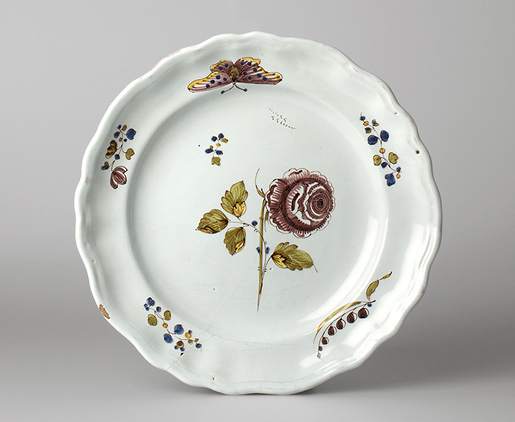
Faience from the Franche-Comté region in Solothurn collections
Roland Blaettler, 2019
In the 18th century, the French-speaking part of Switzerland was an important sales area for the manufactories in the Franche-Comté region of France and, as a consequence, many objects that are assumed to have originated from there can be found in Swiss collections, particularly along the southern foot of the Jura mountains.
This group of vessels, which are rather poorly documented, includes a substantial number of faience objects bearing a maker’s mark that resembles the letter ‘g’ and was deciphered as ‘cg’ by Rudolf Schnyder (see e.g. SFM 36; SFM 34; SFM 38). As a result, these pieces are now associated with Claude Gautherot’s manufactory in Boult in the Dép. Haute-Saône (Rosen 2013, 17–22).
The enterprise was originally founded by Jacques Gautherot, and upon his death in 1762, was taken over by his son, Claude, who then went on to set up a second factory in Le Cordonnet, a municipality near Boult. Many of the decorative elements used in Boult (and in Le Cordonnet) were imitations of popular motifs from the Chambrette Manufactory in Lunéville in the Lorraine region of France, for instance the so-called “crane motif” in purple camaieu (which in actual fact is a phoenix of Chinese origin) and other variants (SFM 36; SFM 34; SFM 38; SFM 39; SFM 37; SFM 35; HMO 8712). On the original “crane motif” see e.g. MAHN AA 1666; MAHN AA 1668; MAHN AA 1664; Schnyder 1973, Fig. 9 and Rosen 2013, 17–19.
In the 1940s, Maria Felchlin put forward the theory that these products had come from Matzendorf and associated them with the period between 1812 and 1820, which at the time was still poorly documented (Felchlin 1942, 25–26). She based her attribution on the fact that the faience maker Marx Frei from Lenzburg worked in Matzendorf in 1808 (Felchlin 1968, 160–161). Given that the “crane motif” in its original form as well as other motifs from Lunéville were attributed to Lenzburg at the time, her conclusion appeared to make perfect sense. The error was only discovered and rectified in 1973 by Rudolf Schnyder (Schnyder 1973).
Incidentally, almost all faience vessels decorated with the “crane motif” from the Canton of Solothurn that have been added to the database came from Maria Felchlin’s private collection. See also “Matzendorf/Aedermannsdorf, Faience Manufactory”.
Translation Sandy Haemmerle
References:
Felchlin 1942
Maria Felchlin, Die Matzendorfer Keramik. Ein Beitrag zur Geschichte der schweizerischen Keramik, in: Jahrbuch für solothurnische Geschichte 15, 1942, 1–72.
Felchlin 1968
Maria Felchlin, Matzendorf in der keramischen Welt, in: 968–1968: Tausend Jahre Matzendorf, Solothurn 1968, 151–216.
Rosen 2013
Jean Rosen, De Lunéville à la Franche-Comté: un exemple de diffusion précoce des décors de la Manufacture Chambrette, vers 1755-1760, in: Deuxième table ronde franco-suisse: Faïences et faïenceries de l’Arc jurassien et ses marges. Procédés techniques et décors. L’apport des sources et de l’archéologie, Fribourg 2013, 15-22.
Schnyder 1973
Rudolf Schnyder, Fayencen 1740–1760 im Gebiet der Schweiz, Zürich 1973.

